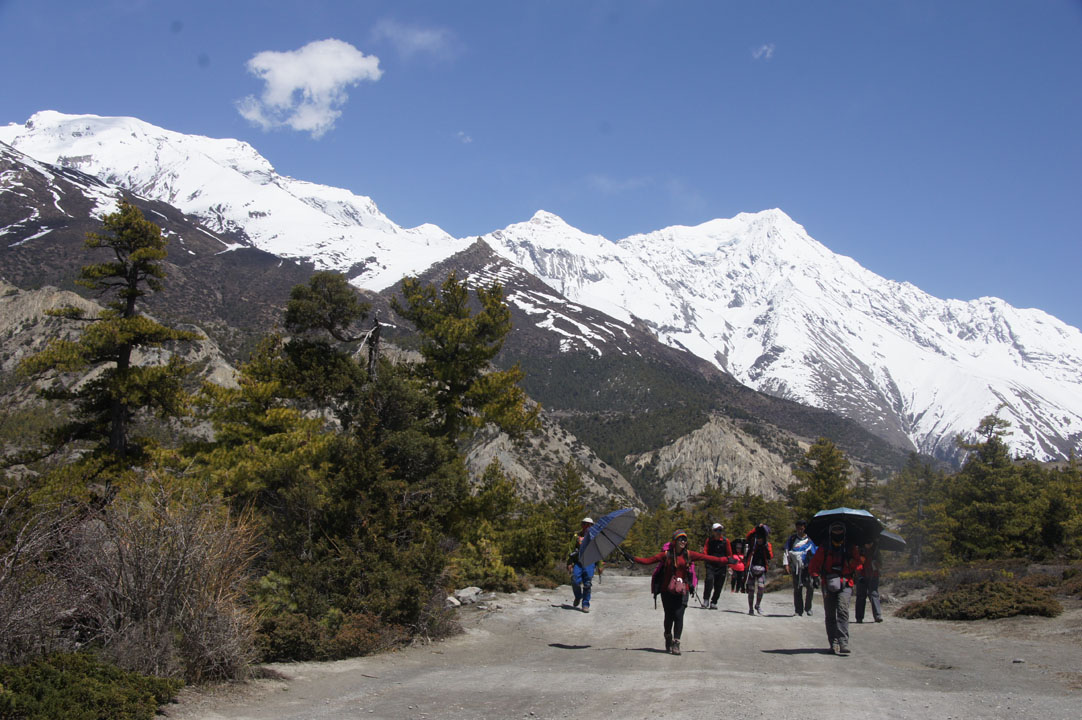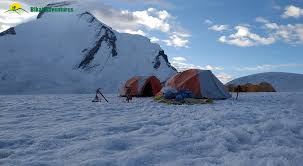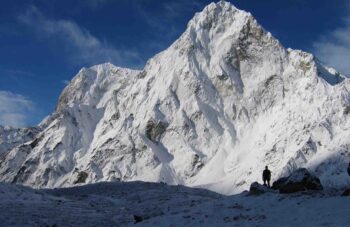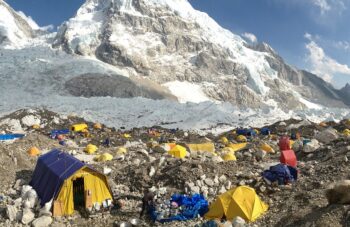ANNAPURNA CIRCUIT + TILICHO LAKE + GHOREPANI TREK
Overview
The Annapurna Circuit +Tilicho Lake +Ghorepani Trek is a breathtaking journey through the majestic landscapes of the Annapurna region in Nepal. It is a perfect blend of natural beauty, diverse cultures, and challenging terrains, making it a dream destination for trekkers and nature enthusiasts.
Starting from the vibrant city of Kathmandu, the trek takes adventurers through lush forests, picturesque villages, and awe-inspiring valleys. The trail also leads to the high-altitude Tilicho Lake, one of the highest lakes in the world, which nestled amidst the Annapurna and Gangapurna mountain ranges. The emerald waters of the lake mirror the surrounding snow-capped peaks, creating a mesmerizing sight that leaves trekkers in awe.
The trek follows well-marked paths, passing through rustic settlements where trekkers can experience the unique culture and lifestyle of the local inhabitants. Teahouses along the route provide a cozy place to rest, relish warm meals, and interact with fellow trekkers, creating a sense of camaraderie.
The challenging aspects of the trek lie in crossing the Thorong La Pass, standing at a breathtaking altitude of 5,416 meters. The crossing also offers a feeling of accomplishment as trekkers reach its pinnacle and rewards with panoramic views of the Annapurna and Dhaulagiri mountain ranges.
Throughout the journey, trekkers encounter diverse flora and fauna, including endangered species like the snow leopard and blue sheep, making it a paradise for wildlife enthusiasts and photographers.
The Annapurna Circuit Tilicho Lake Trek usually takes around 14-18 days to complete, depending on the route and acclimatization breaks. It is also essential to be physically fit and prepared for altitude-related challenges.
The trek best undertaken during the pre-monsoon (spring) and post-monsoon (autumn) seasons, as the weather conditions are more stable and offer clear views of the mountains.
Conclusion and Summary
In conclusion, the Annapurna Circuit +Tilicho Lake +Ghorepani Trek is a soul-stirring adventure that offers a perfect combination of natural beauty, cultural encounters, and physical challenges, leaving trekkers with memories that last a lifetime. It is an opportunity to immerse oneself in the grandeur of the Himalayas and experience the warm hospitality of the Nepalese people while discovering the hidden gems of this enchanting region.
Itinerary
-
DAY 01: DRIVE FROM KATHMANDU BESISHAR TO SYANGE OR JAGAT
We begin our long drive to Syange early in the morning. En route we get to enjoy the countryside of Nepal with its green hills, winding rivers, terraced farms and of course the mighty Himalayas. Overnight in Syange or Jagat.
-
DAY 02: SYANGE - DHARAPANI 1860M - 6HRS
We awake to a morning climb, head steeply up through a forest to a wonderful teahouse just before Chamje and marked by a magnificent waterfall on the opposite bank. Chamje is an atmospheric village of traditional-style teahouses, often packed with saddled local horses. After descending to the river and crossing a suspension bridge, we begin a steep climb to some small teahouses at Sattale. After chai, we continue on an undulating path above the river, climb the switch-backing path to the top of the hill, and are treated to the sight of Tal below us on a wide plain by the river. Though it is enclosed by cliffs, the level area is reassuring after the slightly harrowing mountain paths on which we have just traveled. Beyond Tal and the checkpost, the valley narrows and the path becomes high and winding, and in several areas is actually hewn from the rock. Beyond the small village of Karte, there is a bit more exposed trail walking before the path drops again to the river. We cross a suspension bridge, and climb the short distance to the stone kani marking the entrance to Dharapani
-
DAY 03 : DHARAPANI - CHAME 2670M -5 HRS
Continuing to climb through forests of pine and oak, we pass through Danagyu before coming to a thundering waterfall, where we turn left and head up the high trail to Koto. After an hour of lovely, open forests, we reach a clearing at the top of the trail and a charming Tibetan teahouse where we will stop for a break. Pausing for breath, we can look back for views of Manaslu. An hour away is the wonderful Gurung village of Timang, where the villagers might be harvesting their crops of buckwheat or stuffing local sausages. Heading back down to the village of Koto Qupar, our base for the trek up to Nar Phu, we can look straight up at nearby Annapurna II – a stunning sight convincing us that we are deep in the Himalayan mountains! Many of the villagers are the from Nar Phu valley; this is the gateway to their region. Less than an hour brings us to Chame, the local administrative center of Manang, and a large village packed with small shops and tea-houses, an army post and a large school. We bed down here for the evening.
-
DAY 04: CHAME - PISANG 3200M - 5 HRS
It’s a beautiful walk from Chame to Pisang, through woods with some small ascents, and wonderful views of the peaks soaring above us. It’s just a five hour day, so we’ll have the afternoon in Pisang to explore the village, with it’s Tibetan mani stones and gompa, perhaps taking a walk up to Upper Pisang for amazing views of Annapurna II and Annapurna III. Overnight.
-
DAY 05: PISANG - MANANG 3540M- 6 HRS
6 hours walk past a series of unique and colorful chortens to Manang, at 3500m, a village of 500 or so flat-roofed houses, the headquarters for the region, and an interesting village packed with trekkers, bakeries and lodges. Manang is dominated by high peaks – Annapurna III and Gangapurna tower over it, and a dramatic icefall sits just across the river. There is an old gompa on the edge of town, many local teahouses, and some atmospheric, winding streets in the village leading out toward the Thorung La. Finally, guest houses, showers, cold beers! There is a 3 o’clock lecture on altitude by the Himalayan Rescue Association for anyone interested. Overnight.
-
DAY 06: MANANG REST DAY
today is our acclimatization day, with lots of options; a long day-hike to the Ice Lake, a visit to the ‘Hundred Ruppee Lama’ at the cave gompa above Manang, a two-hour hike to Milarepa’s cave across the river from Braga, the HRA talk, or a tour of Manang’s many bakeries. A hike up 300 meters or so for acclimatization is recommended, but nothing too strenuous is required. The guest house is wonderful, a sunny and warm place to gaze at the peaks in the afternoon. Overnight
-
Day 07: Manang to Shrikharka (3745m/12286ft): 4-5 hours
Today is bit easier day to trek to Shrikharka via Khangsar, Trek start after exploring upper Monastery which is right above 200m from Manang. Trek descends to glacier Cross River and ascends until to Khangsar, Khangsar is Tibetan settlement with Buddhism culture. Overnight at guesthouse or tea house at Shrikharka
-
Day 08: Sirikharka to Tilicho Base Camp (4140m/13,583ft): 5-6 hours
Along the way to Tilicho Base Camp lead with few settlements, easy solve walk and finally descends down from gravel way to Tilicho Base Camp. After having Lunch hike to Tilicho Lake (4500m) the highest lake in world, explore around Tilicho Lake and surrounding peaks. Overnight at guesthouse or tea house at Base Camp.
-
Day 09: Visit Tilicho Lake (4,949m/16,138 ft) then trek back to Shrikharka: 5-6 hours
Early in the morning wake up for the Tilicho Lake Visit, after Visiting Lake we will back to Base camp and eat Breakfast or Lunch after it Way to Yak Kharka or Shrikharka is pretty challenging from Tilicho Base Camp. But the day walk is going to be adventurous because first several hours ascend until to top of Khangshar Village, descend to river by narrow way and hike up to Gunsang Village to Yak Kharka with exploring Annapurna mountains rang, other peak, blue sheep and if you are lucky can seen snow leopard on this park. We will be not taking same way to get back. Overnight at guesthouse or tea house
-
Day 10: SRIKHARKA TO YAK KHARKA (4040m/13,020ft): 4-5 hours
It’s not a long day today, but we gain some altitude, so should take it slowly. En route, we will undoubtedly be passed along the trail by galloping Manangi horses, saddled with wonderful (and expensive) Tibetan wool saddle blankets, and their jubilant Manangi riders, bells jingling as they gallop by. We climb past Tengi and Gunsang to Yak Kharka. Overnight.
-
DAY 11: YAK KHARKA - THORUNG PHEDI 4450M - 3HRS
An easy two or three hour walk up to the Thorung La Base Camp Hotel at Thorung Phedi, and after an early lunch, another hour or so to hike up to the lodge at High Camp, where we will stay the night, getting to bed early for our early morning start the next day; pass day! If anyone is having problems with altitude, we have the option of staying at Thorung Phedi Base Camp, where we had lunch, a nice spot to spend the afternoon with its glass windows. Overnight.
-
DAY 12: THORUNG PHEDI- THORUNG LA PASS 5416M -MUKTINATH 3760M- 10 HRS
Up early for the three or four hour walk to the top of the Thorung La at 5400m, where we are treated with spectacular views over Mustang and the surrounding peaks. The descent is almost as demanding as the ascent to the top of the pass, so a cup of chai and a snack at the local tea house at Chabarbu, at the bottom of the descent, is a required stop. And on to lower Mustang, which we have actually reached just after the pass, and the serene temple complex of Muktinath. Muktinath is an important pilgrimage site for Buddhists and Hindus situated in a tranquil grove of trees, and contains a wall of 108 waterspouts in the shape of cows heads spouting sacred water, the Jwala Mai temple with a perpetual spouting flame and the pagoda-styled Vishnu Mandir, all of which make up the auspicious combination of earth, fire and water. We stay just five minutes down the trail from Muktinath at Ranipauwa
-
DAY 13: DRIVE FROM MUKTINATH TO TATOPANI
In the morning we visit the Muktinath Temple which a sacred place for both Hindus and Buddhists. In Hinduism, the temple is believed to be a sacred place called Mukti Kshetra, which literally means the “place of liberation or moksha”. After a visit to the sacred place, we drive to Tatopani and spend the night. 4- 6 Hours.
-
DAY 14: TATOPANI - SIKHA 1953 - GHOREPANI 2860M- 7-8 HRS
Get ready for some more hills! Today’s walk is a hot one, and quite strenuous as we branch off after an hour of walking from Tatopani from the trail heading to Beni, and take the Ghorepani trail, starting straight up hill. Get ready for some more hills! Today’s walk is a hot one, and quite strenuous as we branch off after an hour of walking from Tatopani from the trail heading to Beni, and take the Ghorepani trail, starting straight up hill.
-
DAY 15: GHOREPANI TREK - POON HILL 3193M – TADAPANI 2630M- 6 HRS
Those who want can hike up Poon Hill for a 360 degree Himalayan panorama; one of the best view point in Nepal. You can spot whole annapurna range with Dhaulagiri. After breakfast, we have a half day’s walk to Tadapani, where we’ll be treated to spectacular views of Machapuchare. Watch for monkeys on the way up! Overnight.
-
DAY 16: TADAPANI TREK TO GHANDRUK 1940M- 4 HRS
We descend through an old, open forest – and it’s important to trek in a group today, as this region used to be know for ‘dacoits’ – to the village of Gandruk, a Gurung village still existing in its traditional state. Again, perfect views; as well, there is a Gurung museum, worth a visit, and several small restaurants serving traditional Gurung fare such as fermented, sour spinach soup. Yum!
-
DAY 17: GHANDRUK - NAYAPUL-1070M 5 HRS AND DRIVE TO POKHARA 820M 1 HRS
A golden, scenic last day of trekking through the terraced rice fields below Gandruk on the way to Kimche. We can look back on the way up to Annapurna Base Camp, far above. About four hours should be enough for us to make it to Naya Pul (new bridge), where we check out of the Annapurna Sanctuary Area, cross the bridge, and catch our ride back to Pokhara, just an hour or so down the road. We spend the night in a nice guest house with hot showers, and eat out at the one of the cool Cafe, where the beers are really cold, the food delicious and the atmosphere great.
-
DAY 18: DRIVE OR FLY BACK TO KATHMANDU
After breakfast, we say goodbye to the beautiful lake city of Pokhara and drive towards Kathmandu. After reaching Kathmandu we have the rest of the day off to rest or do some souvenir shopping. To celebrate the successful completion of our journey, we will have a farewell dinner in the evening.
Driving: 5-6 hrs
-
DAY 19: DRIVE OR FLY BACK TO KATHMANDU
Our adventure in Nepal comes to an end today! Everest Expeditions Nepal representative will escort us to the airport approximately 3 hours before our scheduled flight. On our way home, we have plenty of time to plan our next adventure in the wonderful country of Nepal.
Important note on itinerary: Although Ever effort will be made to follow the schedule above, this itinerary is subject to change due to weather conditions, route conditions, conditions of trekkers, conditions of staff and other factors which is beyond our control.
Enjoy Trek!
Include / Exclude
Cost Includes:
-
- Airport Pick-up and Drop Off,
- Licensed and trained trekking guides,
- potters for carrying goods and supplies,
- Meal on full board (breakfast, lunch, dinner) basis during the trek
- 3 Nights Accommodation in the 3 Star Hotel in Kathmandu with B & B. (Bed & Breakfast) on Twin Sharing Basis.
- All accommodation on Tent during the trek on sharing Basis.
- All meals and hot beverages during the trek.
- Transportation to and from trail head by Private and Sharing Transport
- All necessary documents and permits for trekking (where applicable)
- National Park/Conservation Area entry Permit, Insurance, and
equipment for the staffs. - Coordination of quick Rescue service (Costs covered by your Insurance Plan)
- Trekking staffs wages etc.
- Welcome dinner in a Nepali Cultural Dance restaurant in Kathmandu.
- Trekking Map, T-shirt, and Trekking certificate.
- Exclusive of Medical Kit Bag
- All Government and local Taxes
- International Flight ticket re-confirmation.
- Meals will be Start when your Trek starts.
- Domestic Flights
- Domestic Flights for Trekking Guide.
- Trekking Staff Insurance of $10,000 Per Person.
Cost Excludes:
- International Airfares,
- Travel/Trekking Insurance,
- Excess baggage charges More than 16kg and hand bag more than 5 kg in domestic flights.
- Visa fees.
- Airport Departure Taxes.
- Drinks (Cold and Alcoholic) Rescue charge.
- Tips for The staffs.
- Expenses of Personnel nature and Permit and Liaison officer fee (where Applicable.
- Meals during stay in the Kathmandu
- Extra Domestic Ticket of Jomsom, Pokhara etc.
- Extra Hotel in Kathmandu and Pokhara
Price per person
Usefull Information
Equipment List
EQUIPMENTS AND GEAR LISTS:
First, you need a base layer of clothes for the EBC Trek depending on the weather. A warm white layered jacket, summer pants, a thick layered jacket well insulated for winter, and a raincoat for the rainy season. Likewise, other gear includes trekking shirts, hats, sunglasses, gloves, sunscreen, wool socks, hiking boots, and hiking sandals. It is better to use hiking poles for the steep, slippery, and uneven roads.
Also, here’s a list of gear for the Everest Base Camp Trek.
Head, Face, and Neck
- Sun hat or cap (day)
- Fleece beanie/woolen cap (night)
- Balaclava (optional)
- sunglasses
- Sunscreens
- Moisturizers
- Lip Balm
- Face towel
- Scarf
- Neck gaiters
Upper Body
- T-shirts (preferably quick-dry and breathable) (day)
- Parka/windbreaker (day)
- Rain gear/poncho
- Inner thermal (at night)
- Fleece T-shirts (night)
- Fleece jacket
- Down jacket (night)
Lower Body
- Undergarments
- Trekking pants (preferably stretchable, quick-dry, water-resistant) (day)
- Rain gear
- Inner thermal (at night)
- Fleece/wool pants (night)
- Hands
- Light/outdoor gloves (day)
- Warm winter gloves, fleece or woolen gloves (night)
Legs
- Thin socks (day)
- Warm woolen socks (at night)
- Hiking boots (preferably GORE-TEX) with spare shoelaces
- Floaters or sandals
- Knee support (optional)
- Essential Items
- Passport
- Extra passport-size photos (min. 2) for trekking permit
- Cell phone and charger
- Money
- Backpack and rain jacket
- Duffel bag*
- Padlocks
- Rain cover and a day pack (30L)
- Trekking pole
- Sleeping Bag
- Personal medicine
- water bottle
Toiletries
- Toothpaste and toothbrush
- Facial wash, soap, and shampoo
- Tissues or wet wipes
- Toilet rolls
- Hand sanitizer
- Quick-dry towel
- Handkerchiefs (optional)
- **Basic first-aid kit
Others (Optional)
- Thermo flask
- Portable water filter/purification tablets
- Earplug
- A Universal Adaptor
- Camera, memory card, and charger
- Reading book or map
- Binoculars
- Watch
- Snack
Note: The items with a “*” sign are the special equipment that can be provided to you by Everest Expeditions Nepal upon your request. You can ask for items like duffels. You shall return these items upon completion of the trek/climb. We will also provide a basic first aid kit to you. However, if you are a regular user of medicine and have your own, you can bring them with you.
Physical Preparation for Everest Base Camp Trek:
- PRACTICE HIKES
- Hike or take a long walk
- Build up to 5-6 hours with minimal rests
- Choose hilly, uneven terrain whenever possible
- Wear your daypack and slowly increase the weight of its contents to 25lbs over time
- GYM WORKOUT
- 45 minutes on the treadmill hill setting at a walk or slow job
- 10 minutes stair-stepping machine for at a speed of 30-45 steps per minute
- 5 minutes slow walk with no incline to catch your breath
- Repeat 2-3X
- DO CARDIO TRAINING 2-3X PER WEEK
- Cardio workouts (walking, jogging, swimming, cycling) help train your body to work hard with less oxygen. This will help you keep your breath and focus at high elevation, and to enjoy the hike dramatically more.
Accommodation during the trek:
We provide the standard guesthouses (lodge) accommodation from Lukla to Everest Base Camp and back and standard hotel while in Kathmandu. We want to assure you to satisfy providing quality accommodation, hygienic food and a friendly and knowledgeable guide on our trek.
High Altitude Sickness:
A travel enthusiast’s adventure to Everest Base Camp will last a lifetime. Trekking to Everest Base Camp, which is regarded as a high-altitude trek, is both difficult and exciting. You must consume a lot of food and liquids when traveling to the Everest Base Camp, and appropriate acclimatization is essential. If you have other issues, you must visit the hospital right away; in this situation, you must request a helicopter evacuation. Your trip will undoubtedly be successful if you have the right direction, the right knowledge, enough food and drink, and acclimatization. After speaking with a doctor, you may occasionally be able to utilize medications like Diamox, Paracetamol, and other high altitude-related medications
Telephone, Internet & Electricity:
During your Everest Base Camp trekking, you’ll get telephone access up to Pangboche village and internet access will be available in almost all places except for unusual weather situations that may disturb the internet connection. Each hotel has the wifi where you need to buy a card from Everest Link and you can access the internet. The telephone and internet costs would be the additional cost for your trip. Most of the lodges/ guest houses take an additional charge for battery charging. There is no electricity in all the places in Everest Base Camp Trek. There is electricity or solar power where you can recharge your camera batteries, laptop, mobile, etc. that costs you need to pay extra.
Food and Drinking Water:
We will provide freshly cooked food from the local guest house or restaurant. You will have breakfast and dinner at the lodge and lunch available along the trail. You can find a wide variety of Nepali and Western food as well as drinks during the Everest base camp trekking. Bottled water is available along the trail until the last village. You can buy boiling water from the lodge or restaurant or you can use Iodine or water-purifying medicines. Drinking water can be bought throughout the trek. The price for a bottle of mineral water in Lukla cost you about RS 80 ($ 1 per bottle) and the higher you go, the more expensive it gets, a bottle of mineral water in higher places like Lobuche and Gorakshep will cost you up to RS 300 ($3 per Bottle). We recommend you drink at least 4 liters in a day.
TERMS & CONDITIONS:
Incomplete Tour:
After you start your trek we are not liable for any refunds in case of any incomplete tour, trek, or expedition, whatever the reason from the customer’s side.
Unforeseen Circumstances:
If your trip gets canceled due to unforeseen circumstances like natural disasters, war, or unfavorable climatic conditions, we will arrange another trip for you. So even if your trip won’t be the one you had chosen, your money will not go in vain.
TO BOOK YOUR SEATS:
To book your respective trek, you have to pay only 15% of payments during the booking period and all the remaining payments should be done before one day of your trek.
(If you want to book this trek, then please let us know we’ll send you another email regarding booking too. If you get any confused, do let me know or give me a quick call at Whatsapp: +977 9851116654. I am always here to help you).
FAQs
-
 Best Seasons March to May, September to November
Best Seasons March to May, September to November -
 Group Size 1-15
Group Size 1-15 -
 Duration 19 DAYS BOOKING OPEN
Duration 19 DAYS BOOKING OPEN -
 Maximum Altitude 5416M
Maximum Altitude 5416M -
 Trek Difficulty Challenging
Trek Difficulty Challenging








Leave a Reply